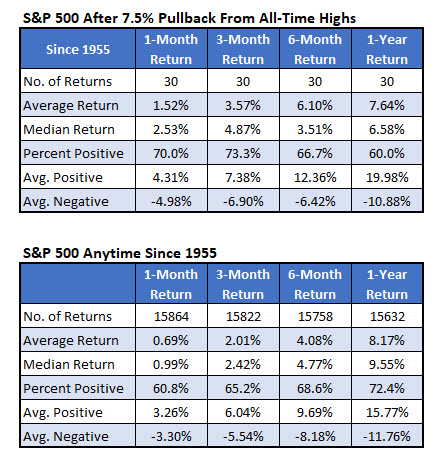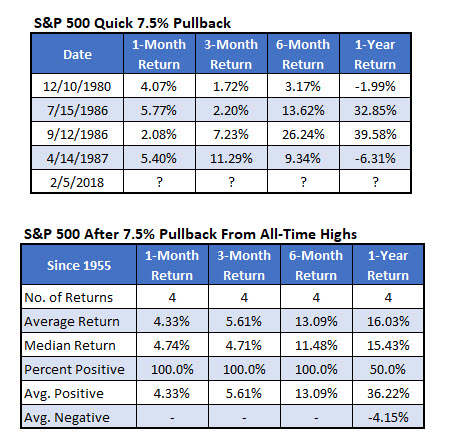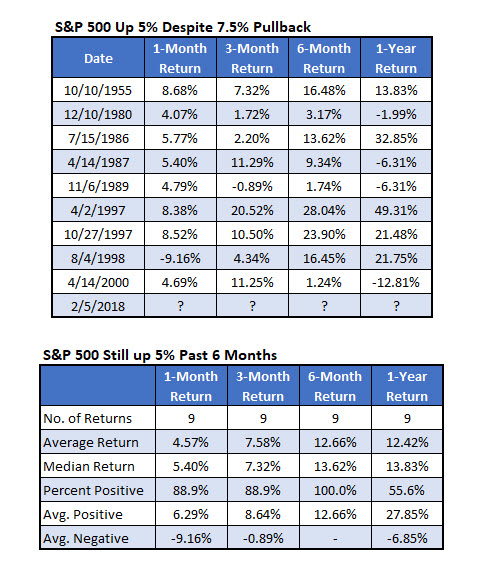Behind the Fastest Pullback from Record Highs in 30 Years
What else is there to talk about after the largest single-day decline in the history of the Dow Jones Industrial Average (DJIA) and S&P 500 Index (SPX)? In this article, I'm going to focus on the S&P 500, which closed about 8% off its highest level ever on Monday, and barely stayed above correction territory -- often defined as a 10% pullback -- on an intraday basis. Below, I'll try to answer what happens after severe pullbacks from all-time highs. Is this what the beginning of a crash looks like? Or will things calm down quickly, making right now a buying opportunity?
General Pullbacks From All-Time Highs
Using historical data on the S&P 500 since 1950, I looked at times the index fell 7.5% from new all-time highs. In this time frame, there have been 30 other pullbacks of this magnitude. The table below summarizes how the S&P 500 performed going forward. I then showed the typical data since 1955 (the year of the first signal) for comparison.

In the short term,three months after a signal, stocks looked to outperform their usual returns, but with more volatility. The average returns and percent positive both beat out the typical S&P returns, but the magnitude of the average positive and negative was higher after a signal.
Looking out longer term, stocks stalled out a bit after the initial pop. The one-year S&P returns underperform typical returns. However, these general pullbacks don't necessarily portend a crash. The downside volatility, measured by the average negative return, was muted some after these pullbacks, looking out six and 12 months.
Fastest Pullback From All-Time Highs Since 1987
This recent pullback seemed especially quick, though. Barely a week after hitting all-time highs, this market was down 7.5%. The first table below shows each instance that the S&P 500 hit an all-time high and then pulled back at least 7.5% within two weeks. The second table summarizes the data.

As you can see, after each occurrence -- the last of which happened in 1987 -- stocks spiked higher. The index gained at least 4% over the next month every time. Six months later, the S&P 500 was higher each time and averaged a double-digit percentage gain.
After that, though, the index pulled back on two occasions, causing negative returns a year after the pullback. The two years that weren't negative, however, the index gained at least 30% over the next year. These sharp pullbacks from all-time highs have historically been solid buying opportunities, especially for option players who benefit from big short-term movements.
When the S&P Still Sports a Solid 6-Month Gain
Finally, there's one more way I looked at it. Despite the recent pullback, the S&P 500 was still up almost 7% over the past six months. The table below lists each instance where the index still sported a six-month gain of atleast 5%, even after the pullback. The last time this happened was in April 2000.

Especially in these instances, investors were quick to buy back in. Over the next three months, the S&P 500 gained an average of 7.58%, and was positive in eight of nine occurrences. Over the next six months, the index was higher every single time, averaging a gain of more than 12%. After this six-month spike, it gets interesting. Stocks pulled back four times in that 6-to-12-month time frame, resulting in negative returns a year out.
Based on the analysis above, these quick-hit pullbacks amidst a bull rally created some impressive short-term returns. Hopefully, this trend continues.